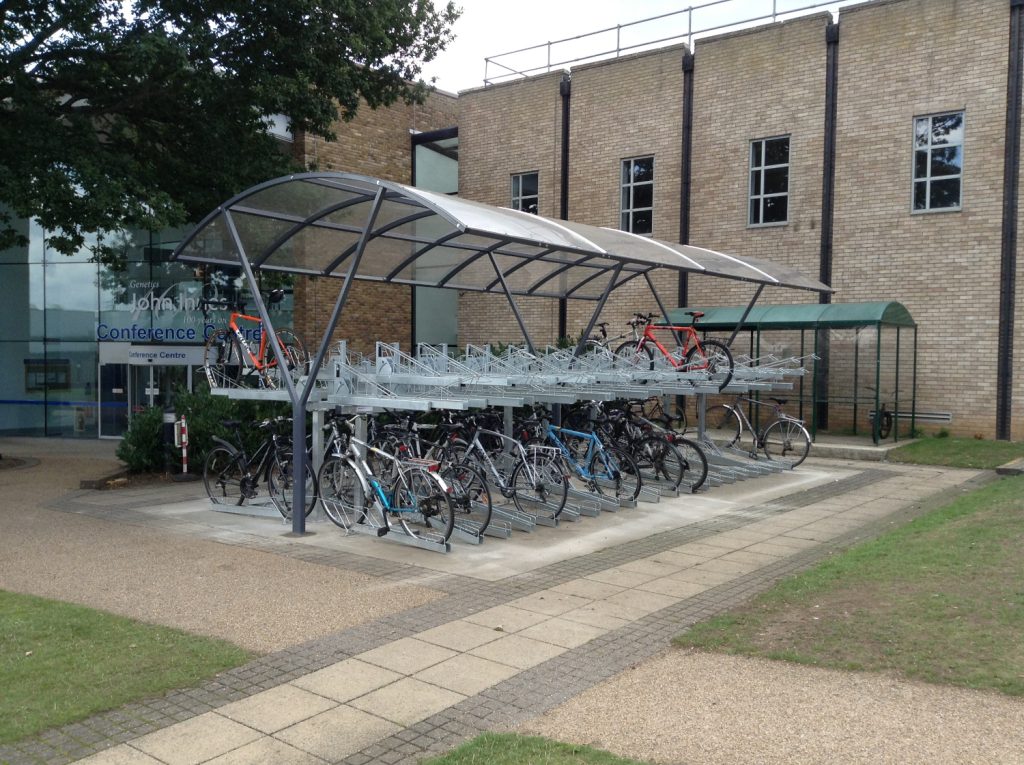The seasons are changing, and you’re probably adding new items to your to-do list. Cleaning the gutters, covering up outdoor furniture for the winter, sweet pumpkin pictures with the family and raking leaves, you should add another really important item to the list – doing your two-tier racks and shelter maintenance.
Autumn and winter bring unique challenges that can affect the functionality and longevity of your two-tier bike racks. If you want them safe, operational, and appealing to cyclists year-round, you should be taking proactive measures to protect them from the elements. Below are some practical tips for preparing your two-tier bike racks for the colder, wetter months ahead.
Regular Inspections and Early Repairs
If there ever was a magical pill, we’d say it would be prevention. Prevention, regular repairs and catching problems early are your best strategies for maintaining your two-tier bicycle racks.
Autumn is the ideal time to conduct a thorough inspection before harsher winter weather sets in. Start by checking for signs of wear and tear, such as rust, loose bolts, or bent bars, which the upcoming rain and frost can exacerbate. The key is obviously, once you find any damage, to repair it as soon as possible and not let the issue get worse. Doing this will extend the lifespan of your racks and keep them safe for users. Plus, fixing minor issues early can save you from costly repairs or replacements in the future.
Protecting Against The Elements
Autumn and winter are synonymous with increased rainfall, frost, and humidity, all of which can contribute to rust and corrosion on bike racks and other bike parking infrastructure.
Prevention, when it comes to this issue, starts at the shop. When selecting a bike storage product for outdoor use, look for constructions made from durable, weather-resistant materials like galvanised steel and powder-coating. This will help prevent corrosion and rust on exposed surfaces.
Additionally, if your two-tier racks are not already covered, installing bike shelters or canopies can help protect both the racks and the bikes from direct exposure to rain and snow. Doing that will reduce rust and wear, which is good news for your racks and cyclists’ bikes. As a bonus, it will also provide cyclists with a more comfortable parking experience during bad weather.
Ensure Proper Drainage & Clearing
Water pooling around bike parking areas can lead to a host of problems, from slippery surfaces and wading through muddy puddles all the way to rust damage. To avoid any of this unpleasantness, make sure that the ground around your bike racks has proper drainage and a decent incline.
With beautiful autumnal colours come falling leaves. Falling leaves can be slippy, clog moving parts and generally make an area look unkempt. So, include the outdoor bike parking area in your cleaning schedule and clear any debris, like fallen leaves or mud. Keep these away, especially from drains and pathways, to ensure rainwater flows away from the racks rather than collecting around them.
As we said above, autumn is the perfect time to inspect the whole area, including the drainage systems. This simple step helps keep your bike parking area safe for users and extends the life of your two-tier racks.
In winter, snow and ice are another thing you need to worry about. They can accumulate around your bike racks, which can make them difficult to access and potentially dangerous. Ensure that walkways and parking areas are cleared of snow and ice promptly. Applying salt or grit to surfaces can help prevent slipping and keep the area safe for cyclists, even in icy conditions.
Maintain Accessibility and Lighting
There may not be snow every winter, but one thing that you can depend on is the shorter daylight hours. To help with that for both the comfort and safety of the area and cyclists, it’s important to ensure that your bike parking remains well-lit. Good lighting is good for safety and bad for theft and vandalism. A well-lit bike rack area encourages consistent usage, even in less favourable weather conditions.
You can consider installing energy-efficient LED lights or even motion-sensor lighting around your two-tier racks to provide clear visibility during early morning or late evening hours.
Plan for Increased Winter Wear and Tear
With bike parking there are seasonal ups and downs. Spring and summer are high seasons, and more people ride their bikes as the weather gets milder, so you can expect more wear and tear from increased use. In autumn and winter, people get scared away by the rain and snow, and you usually get fewer cyclists on the roads. This shouldn’t, however, lull you into inaction.
Whilst there may be decreased usage, winter weather can be particularly harsh on outdoor infrastructure—snow, ice, freezing cold, and big temperature fluctuations between night and day can take a toll on bike racks, especially those with moving parts like two-tier systems.
Ensure that all mechanical components, such as gas struts or lifting handles, are properly lubricated to prevent stiffness in cold conditions. Keep your bike parking area clean and covered, preventing snow and debris from building up inside and ensuring the racks remain functional throughout the season. Regularly check the condition of these components and perform any necessary maintenance to keep them in tip-top shape.
Preparing your two-tier bike racks and shelters for autumn and winter is always the right move to maintain their functionality and safety throughout the colder months. Regular inspections, early repairs, and proactive measures such as ensuring proper drainage, protecting against the elements, and maintaining accessibility and lighting can significantly extend the lifespan of your bike parking infrastructure. By staying on top of potential weather-related issues—such as rust, snow accumulation, and decreased visibility—you protect your investment and ensure a safe and appealing environment for cyclists. Taking these steps now will help prevent costly repairs and keep your bike racks ready for use year-round.

